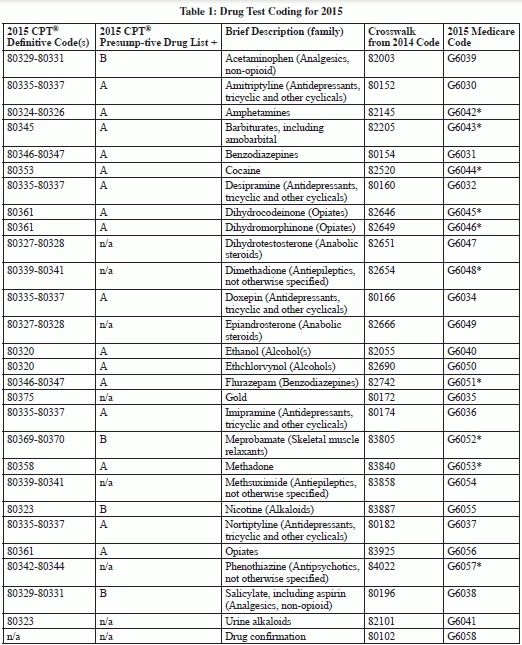Ignore Massive CPT® 2015 Drug Coding Changes for Medicare

Choose from 28 new ‘G’ codes instead.
Learning about the CPT® 2015 toxicology overhaul won’t help you if you’re billing for a Medicare beneficiary. That’s because CMS says it needs more time before setting prices for the new CPT® codes, and therefore won’t recognize them this year.
In the meantime, you should turn to the host of stop-gap HCPCS Level II codes to describe your 2015 drug test services for Medicare.
Do this: Read on to learn how you’ll code toxicology services for Medicare beneficiaries this year. But keep in mind that you’ll have to use the new CPT® 2015 codes if you’re reporting the same services to most other payers.
Check Out the CMS Problem and Solution
CMS opted not to price the 63 new CPT® 2015 toxicology codes due to “concern about the potential for overpayment when billing for each individual drug test,” according to the Clinical Laboratory Fee Schedule (CLFS) final determination. Instead, the agency wanted labs to continue to report toxicology procedures as they did in 2014.
Problem: You can’t keep reporting the procedures to Medicare as you did in 2014, because CPT® 2015 revises or deletes all of the existing drug screening codes and many toxicology codes in the chemistry and therapeutic drug assay sections of CPT®.
Solution: CMS provides 28 new HCPCS Level II codes that you should use to report these services to Medicare, instead of using the new CPT® 2015 drug test codes.
Take These Steps for 2015 Medicare Reporting
“Unfortunately, the CMS solution is not that simple to implement,” cautions Marcella Bucknam, CPC, CCS-P, CPC-H, CCS, CPC-P, CCC, COBC, CPC-I, internal audit manager at PeaceHealth in Vancouver, Wash.
“To bill Medicare, you will first have to code the procedure as you would have done in 2014 and then crosswalk that code to the appropriate ‘G’ code for Medicare,” she says. Remember that many of the 2014 codes are deleted, so they might not be in your system anymore.
“But in some cases, CPT® 2015 revises drug-test code descriptors or instructions rather than deleting them, and that leads to other problems that CMS doesn’t solve with the new ‘G’ codes,” explains William Dettwyler, MT AMT, president of Codus Medicus, a laboratory coding consulting firm in Salem, Ore.
Do this: In the case of revised CPT® 2015 drug-test codes or instructions, CMS tells you to “use these codes exactly as [you] used them for 2014, regardless of the 2015 instruction or code descriptor changes.”
More confusion: At the same time that you’re trying to implement this alternative coding scheme for Medicare, your lab should be correctly coding the same procedures using the new CPT® 2015 toxicology codes. Refer to “Hone Drug Coding With New Sections, Drug Lists” and “Focus on Methods to Direct Your Drug Code Choice” in Pathology/Lab Coding Alert Vol. 16, No. 3 for help on this front.
Turn to Toxicology Selection Tool
With all of those complicated instructions, how can you possibly sort it out? Table 1 links all the pertinent data in one place to make your job easier. Use the table and the following easy steps as a handy tool to make sure you select the proper code for definitive drug testing:
Presumptive is different: Remember that CPT® 2015 introduces the concept of “presumptive” versus “definitive” drug testing. The table lists the 2015 codes for definitive drug tests, which are more specific tests that can identify individual drugs and distinguish between structural isomers. If your lab performs a more general drug screen that doesn’t specifically identify the drug, you should not use these codes, but should instead turn to 80300-80304 (Presumptive drug class screening …), which replace deleted codes 80100, 80101, and 80104. Column 2 in Table 1 references the CPT® 2015 drug list, A or B, for the drug in column 3, which corresponds to the appropriate presumptive test code listed in the footnote.
Except for Medicare: Just as CMS did not accept 80100, 80101, and 80104 in past years, the agency isn’t accepting 80300-80304 this year. Instead, you should continue to report drug screening tests with one of the following codes:
Specifically, the CLFS final determination directs you to use G0431 or G0434 for qualitative tests for amobarbital, amphetamine or methamphetamine, barbiturates, cocaine, codeine, dihydrocodeinone, dihydromorphinone, dimethadione, flurazepam, meprobamate, methodone, phencyclidine, phenothiazine, plus specified heroin and marijuana screening tests.
Confirmation test: Under the old system, labs were to report 80102 (Drug confirmation, each procedure) for a confirmatory drug test following a positive screening, or G6058 (Drug confirmation, each procedure) for Medicare. But CPT® 2015 deletes 80102 and instructs you to use the appropriate definitive drug test code for confirmatory testing. Medicare still lists G6058 for confirmation testing, but CMS has not yet indicated whether you should use G6058 or a more specific G code when performing a confirmation test for a specific drug.
+ For presumptive test for list A drug use 80300-80301; for presumptive test for list B drug, use 80302 (except for certain methods such as thin layer chromatography).
*For screening tests for Medicare, use G0431 or G0434.


